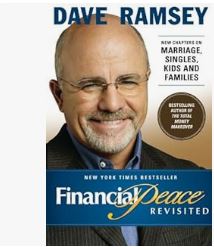 Click on the book to buy on Amazon
Click on the book to buy on Amazon
"Financial Peace Revisited" by Dave Ramsey is an
updated and revised edition of his classic book "Financial
Peace," offering practical advice and strategies for achieving
financial stability and freedom. Ramsey draws on his own
experience of overcoming financial adversity and shares proven
principles for managing money, eliminating debt, and building
wealth. Here's a detailed summary of the key concepts and
chapters:
Introduction: The Road to Financial Peace
Ramsey introduces the concept of financial peace and explains
how it encompasses more than just wealth—it's about living with
financial security, freedom, and peace of mind. He shares his
personal journey from financial ruin to prosperity and outlines
the principles and strategies that readers will learn in the
book.
Part 1: Assessing Your Financial Situation
Chapter 1: Financial Peace University
Ramsey introduces the Financial Peace University program—a
comprehensive financial education course designed to help
individuals and families achieve financial freedom. He discusses
the importance of taking control of your finances, setting
goals, and creating a plan for achieving them. Ramsey also
shares insights into the structure and content of the Financial
Peace University program.
Chapter 2: The Four Walls
In this chapter, Ramsey explores the concept of the Four
Walls—the basic necessities of life that should be prioritized
when managing money. He discusses the importance of covering
essential expenses, such as housing, utilities, food, and
transportation, before addressing other financial obligations.
Ramsey shares practical tips for budgeting and prioritizing
spending to ensure that the Four Walls are always protected.
Chapter 3: Tithing and Giving
Ramsey discusses the importance of generosity and giving back
as part of achieving financial peace. He explores the concept of
tithing—giving a portion of income to support charitable
causes—and explains how it can help individuals align their
values with their financial goals. Ramsey shares stories of
generosity and the positive impact it can have on both personal
finances and the community.
Part 2: Building a Strong Financial Foundation
Chapter 4: Creating a Budget
Ramsey explores the importance of budgeting as a foundational
tool for managing money effectively. He discusses the principles
of budgeting, such as tracking income and expenses, prioritizing
spending, and living within your means. Ramsey shares practical
tips and techniques for creating a budget that aligns with your
financial goals and values.
Chapter 5: Eliminating Debt
In this chapter, Ramsey discusses the dangers of debt and the
importance of getting out of debt as a priority. He explores the
concept of the debt snowball method—an approach to debt
repayment that focuses on paying off debts from smallest to
largest—and explains how it can help individuals gain momentum
and motivation on their debt-free journey. Ramsey shares stories
of individuals who have successfully eliminated debt and
achieved financial freedom.
Chapter 6: Building Wealth
Ramsey examines the principles of wealth-building and the
importance of saving and investing for the future. He discusses
the concept of the Baby Steps—a series of financial goals and
milestones designed to help individuals achieve financial
peace—and explains how they can be customized to fit individual
circumstances. Ramsey shares practical strategies for saving,
investing, and building wealth over time.
Part 3: Achieving Financial Peace
Chapter 7: Understanding Insurance
Ramsey explores the importance of insurance as a tool for
protecting assets and managing risk. He discusses different
types of insurance, such as health insurance, life insurance,
and property insurance, and explains how they can provide
financial security and peace of mind. Ramsey shares tips for
evaluating insurance needs and selecting appropriate coverage.
Chapter 8: Retirement and College Planning
In this chapter, Ramsey discusses the importance of planning
for the future through retirement and college savings. He
explores the concept of retirement planning and the importance
of saving and investing early and consistently for retirement.
Ramsey also shares strategies for saving for college expenses
and balancing competing financial priorities.
Chapter 9: Real Estate and Mortgages
Ramsey examines the role of real estate in achieving
financial peace and the principles of responsible home
ownership. He discusses the pros and cons of renting versus
buying a home and offers guidance on selecting a mortgage and
avoiding common pitfalls. Ramsey shares insights into the
benefits of real estate investing and how it can help
individuals build wealth over time.
Conclusion: Your Journey to Financial Peace
Ramsey concludes the book by reaffirming the possibility of
achieving financial peace for anyone willing to take control of
their finances and follow the principles outlined in the book.
He offers a message of hope, encouragement, and empowerment to
readers, emphasizing the transformative power of financial peace
in creating a life of security, freedom, and abundance. Ramsey
encourages readers to take action, set goals, and commit to
their own journey to financial peace.